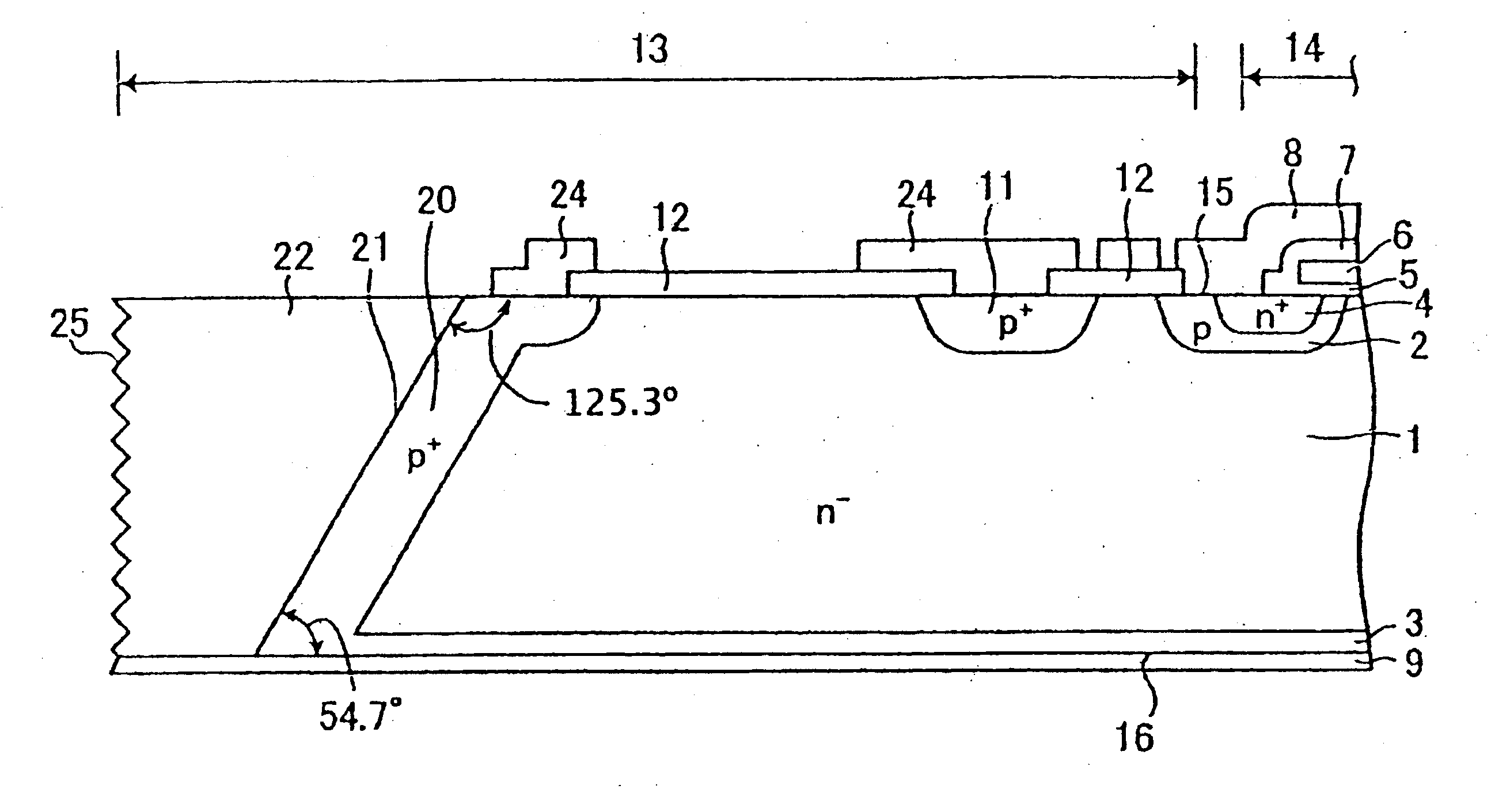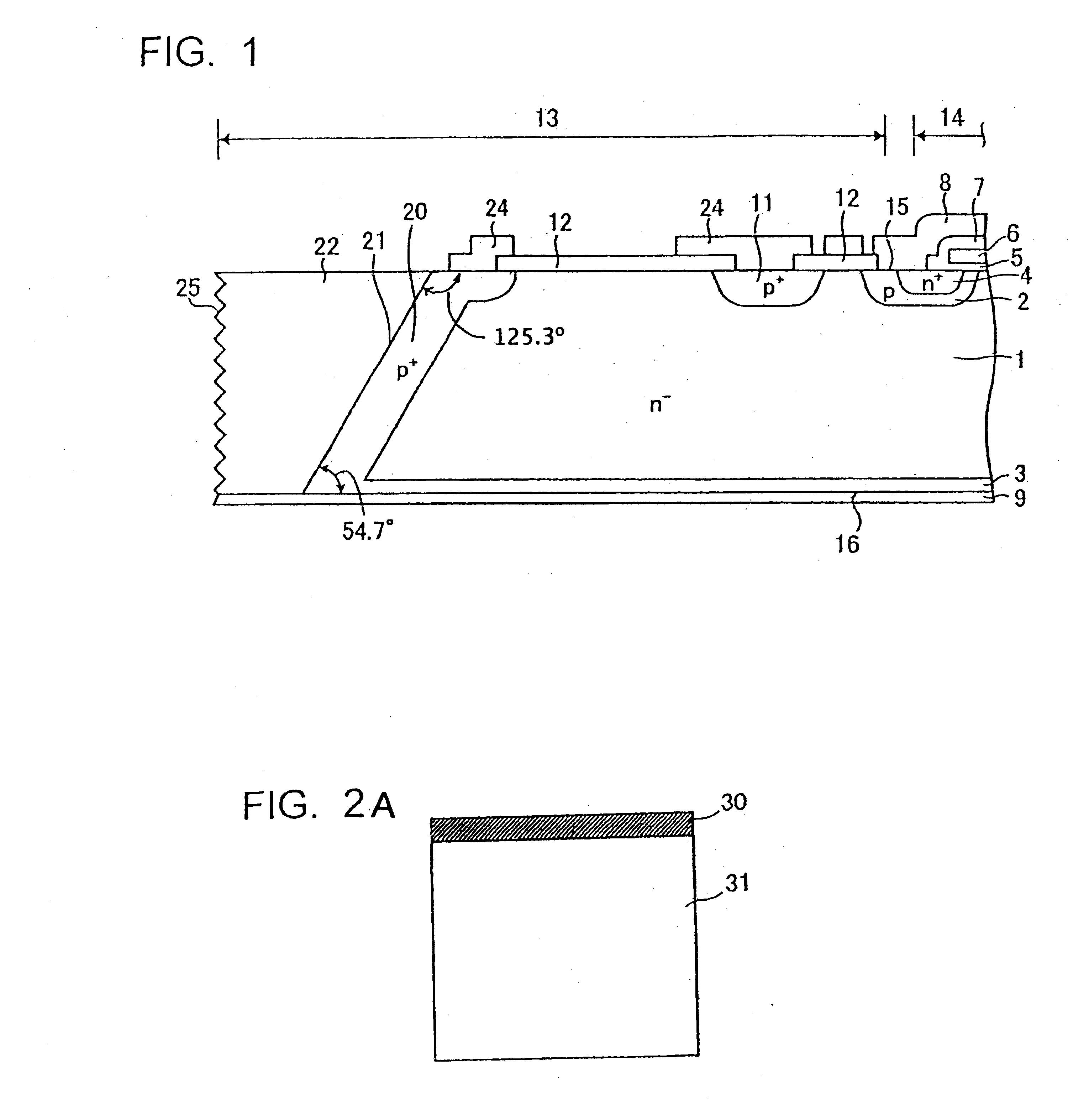Semiconductor device and manufacturing method thereof
a semiconductor and semiconductor technology, applied in the direction of semiconductor devices, electrical devices, transistors, etc., can solve the problems of large amount of oxygen, reduced heat and strength, and long oxidation time of about 15 hours, and achieves small device pitch, high reliability, and small chip size
- Summary
- Abstract
- Description
- Claims
- Application Information
AI Technical Summary
Benefits of technology
Problems solved by technology
Method used
Image
Examples
embodiment 1
[0129]FIG. 1 is a cross sectional view showing an arrangement of a reverse-blocking IGBT according to embodiment 1 of the invention. As is shown in FIG. 1, on first principal surface 15 of n− silicon semiconductor substrate 1 with high resistivity, a plurality of p base regions 2 are selectively formed. On second principal surface 16 on a bottom surface side of the substrate, p+ collector layer 3 is formed. A region in between p base regions 2 and p+ collector layer 3 in the direction of the thickness of the substrate is originally n− single crystal silicon semiconductor substrate 1, which becomes an n base region. Although not particularly limited, the thickness of n− silicon semiconductor substrate 1, that is, the dimension from first principal surface 15 to second principal surface 16 is 200 μm, for example.
[0130] In active region 14 a part of which is shown by an arrow, n+ emitter region 4 is selectively formed in the surface layer in each p base region 2. On the outside of act...
embodiment 2
[0146]FIG. 3 is a cross sectional view showing an arrangement of a reverse-blocking IGBT according to embodiment 2 of the invention. As is shown in FIG. 3, the IGBT according to embodiment 2 has an arrangement in which, in the arrangement according to embodiment 1, filler region 22 between p+ isolation layer 20 and dicing face 25 is made to extend onto first principal surface 15 to cover voltage withstanding structure 13 and active region 14. The other arrangements are the same as those in embodiment 1. Therefore, as in embodiment 1, p+ isolation layer 20 can prevent a depletion layer, spreading around the p-n junction when the IGBT is reverse-biased, from expanding toward dicing face 25 and the damage region around it to allow the IGBT to obtain a sufficiently high reverse breakdown voltage. Elements similar to those in embodiment 1 are denoted with the same reference numerals and signs as those in embodiment 1, and explanations about these are omitted.
[0147] Next, a manufacturing...
embodiment 3
[0154]FIG. 10 is a plan view showing an arrangement of a thin semiconductor wafer in which a number of semiconductor chip forming areas of the semiconductor devices (here, reverse-blocking IGBTs) according to the invention are integrated. FIG. 11 is a cross sectional view showing an arrangement of a principal part of the semiconductor chip forming the area cut on line C-C in FIG. 10. FIG. 12 is an enlarged cross sectional view showing arrangements of the section D and the section E in FIG. 11. The thin semiconductor wafer is shown with the second principal surface of a thick semiconductor wafer, on the first principal surface of which a top surface structure is formed, being ground and with a bottom surface structure being formed on the ground second principal surface. No trench to be the scribing line and no isolation layer to be formed in the trench are therefore formed yet.
[0155] In IGBT chip forming area 135 on the side of first principal surface 131 of thin semiconductor wafer...
PUM
 Login to View More
Login to View More Abstract
Description
Claims
Application Information
 Login to View More
Login to View More - R&D
- Intellectual Property
- Life Sciences
- Materials
- Tech Scout
- Unparalleled Data Quality
- Higher Quality Content
- 60% Fewer Hallucinations
Browse by: Latest US Patents, China's latest patents, Technical Efficacy Thesaurus, Application Domain, Technology Topic, Popular Technical Reports.
© 2025 PatSnap. All rights reserved.Legal|Privacy policy|Modern Slavery Act Transparency Statement|Sitemap|About US| Contact US: help@patsnap.com



